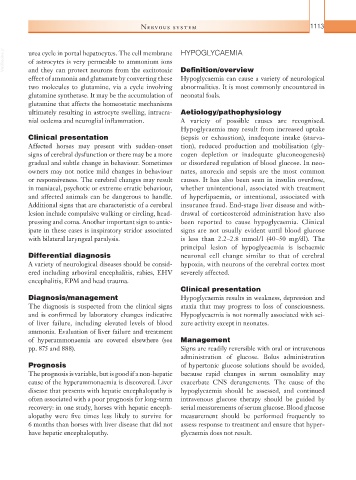Page 1138 - Equine Clinical Medicine, Surgery and Reproduction, 2nd Edition
P. 1138
Nervous system 1113
VetBooks.ir urea cycle in portal hepatocytes. The cell membrane HYPOGLYCAEMIA
of astrocytes is very permeable to ammonium ions
and they can protect neurons from the excitotoxic Definition/overview
effect of ammonia and glutamate by converting these Hypoglycaemia can cause a variety of neurological
two molecules to glutamine, via a cycle involving abnormalities. It is most commonly encountered in
glutamine synthetase. It may be the accumulation of neonatal foals.
glutamine that affects the homeostatic mechanisms
ultimately resulting in astrocyte swelling, intracra- Aetiology/pathophysiology
nial oedema and neuroglial inflammation. A variety of possible causes are recognised.
Hypoglycaemia may result from increased uptake
Clinical presentation (sepsis or exhaustion), inadequate intake (starva-
Affected horses may present with sudden-onset tion), reduced production and mobilisation (gly-
signs of cerebral dysfunction or there may be a more cogen depletion or inadequate gluconeogenesis)
gradual and subtle change in behaviour. Sometimes or disordered regulation of blood glucose. In neo-
owners may not notice mild changes in behaviour nates, anorexia and sepsis are the most common
or responsiveness. The cerebral changes may result causes. It has also been seen in insulin overdose,
in maniacal, psychotic or extreme erratic behaviour, whether unintentional, associated with treatment
and affected animals can be dangerous to handle. of hyperlipaemia, or intentional, associated with
Additional signs that are characteristic of a cerebral insurance fraud. End-stage liver disease and with-
lesion include compulsive walking or circling, head- drawal of corticosteroid administration have also
pressing and coma. Another important sign to antic- been reported to cause hypoglycaemia. Clinical
ipate in these cases is inspiratory stridor associated signs are not usually evident until blood glucose
with bilateral laryngeal paralysis. is less than 2.2–2.8 mmol/l (40–50 mg/dl). The
principal lesion of hypoglycaemia is ischaemic
Differential diagnosis neuronal cell change similar to that of cerebral
A variety of neurological diseases should be consid- hypoxia, with neurons of the cerebral cortex most
ered including arboviral encephalitis, rabies, EHV severely affected.
encephalitis, EPM and head trauma.
Clinical presentation
Diagnosis/management Hypoglycaemia results in weakness, depression and
The diagnosis is suspected from the clinical signs ataxia that may progress to loss of consciousness.
and is confirmed by laboratory changes indicative Hypoglycaemia is not normally associated with sei-
of liver failure, including elevated levels of blood zure activity except in neonates.
ammonia. Evaluation of liver failure and treatment
of hyperammonaemia are covered elsewhere (see Management
pp. 875 and 888). Signs are readily reversible with oral or intravenous
administration of glucose. Bolus administration
Prognosis of hypertonic glucose solutions should be avoided,
The prognosis is variable, but is good if a non-hepatic because rapid changes in serum osmolality may
cause of the hyperammonaemia is discovered. Liver exacerbate CNS derangements. The cause of the
disease that presents with hepatic encephalopathy is hypoglycaemia should be assessed, and continued
often associated with a poor prognosis for long-term intravenous glucose therapy should be guided by
recovery: in one study, horses with hepatic enceph- serial measurements of serum glucose. Blood glucose
alopathy were five times less likely to survive for measurement should be performed frequently to
6 months than horses with liver disease that did not assess response to treatment and ensure that hyper-
have hepatic encephalopathy. glycaemia does not result.

